Who Controls the User Experience? AMD’s Carrizo Thoroughly Tested
by Ian Cutress on February 4, 2016 8:00 AM ESTGaming Benchmarks: 3DMark and Rocket League
Due to timing we were only able to run a couple of gaming tests, namely parts of the 3DMark suite and our Rocket League test. A reminder of our systems, including their graphics:
| System Overview | ||||
| µArch | APU + GPU | Memory | Channel | |
| HP Elitebook 745 G2 | Kaveri | A10 PRO-7350B (19W) R6, 384 SPs, 533 MHz |
8 GB | Dual |
| HP Elitebook 745 G3 | Carrizo | PRO A12-8800B (15W) R7, 512 SPs, 800 MHz |
4 GB | Single |
| Toshiba Satellite E45DW-C4210 |
Carrizo | FX-8800P (15W) R7, 512 SPs, 800 MHz |
8 GB | Single |
| HP Pavilion 17z-g100 |
Carrizo | A10-8700P (15W) R6, 384 SPs, 800 MHz |
8 GB | Single |
| Lenovo Y700 | Carrizo | FX-8800P (15W) R7, 512 SPs, 800 MHz R9 385MX, 512 SPs, 900-100 MHz |
16 GB | Single |
One of the biggest issues we’ll see here is the effect of dual channel memory on gaming. The Kaveri system used has a chipset solution that supports dual graphics, but also two memory modules installed. The Carrizo systems either came pre-prepared with one module installed or do not support dual channel memory full stop. This latter point is the main kick in the teeth, especially for a company like AMD that prides itself on gaming – the issue here is down to pin compatibility between Carrizo and Carrizo-L. As the latter only supports single channel, an OEM will design one motherboard to support both platforms (whether they are used for both or not). If a motherboard supports Carrizo-L, then it will not ever support dual channel memory, and any Carrizo APU that is used will be crippled.
Technically the Lenovo Y700 gets around this (hands up if you ever see a Carrizo-L based Y700 please) by equipping the system with a discrete graphics card and disabling Crossfire, so this system will still ultimately win in our tests due to the discrete card. The downside of this augmentation is the higher power draw, which would matter if our Y700 sample had a battery (the retail units come with a 60 Wh battery).
3DMark
3DMark is Futuremark's premium software, developed to tax systems at various different performance levels. The software contains several benchmarks as a result, with some focusing more on smartphone use all the way up to 4K, quad-SLI systems with as many in-game and post processing effects as you can throw at it. The base test, Ice Storm, is actually a good indicator of GPU scaling performance, but we also test Cloud Gate, Sky Diver and Fire Strike to get a measure of all of our systems.
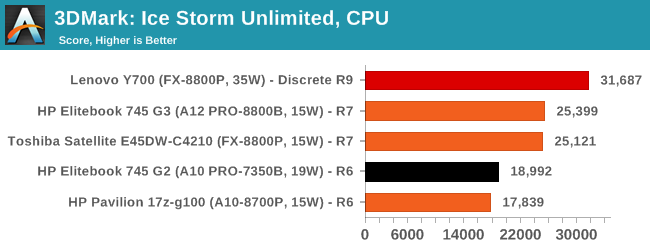
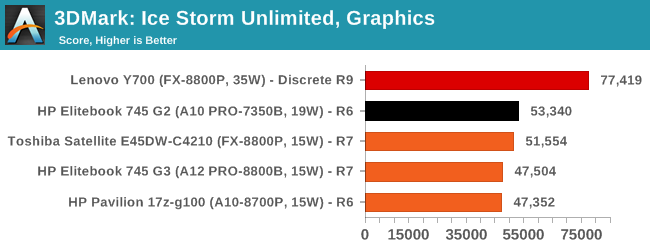
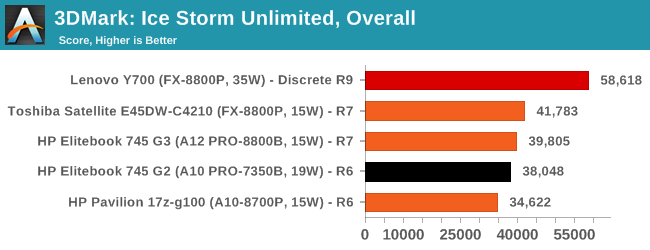
The easiest test, Ice Storm, shows the performance benefits of the Carrizo APUs in the CPU stage, although the dual channel memory for the Kaveri kicks in and gives it the graphics lead. The overall scores however benefit from that high CPU boost, so Carrizo at 15W on single channel wins this round.

Moving up in difficulty to Cloud Gate puts dual channel Kaveri in the lead, although the Toshiba is holding on a bit with its higher thermal skin temperature limit.
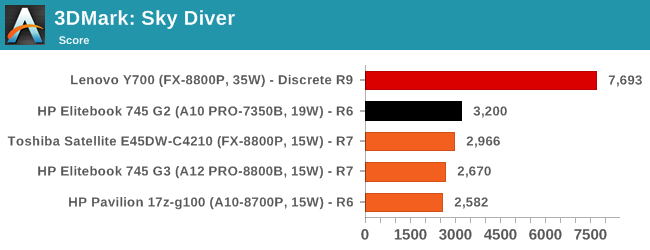
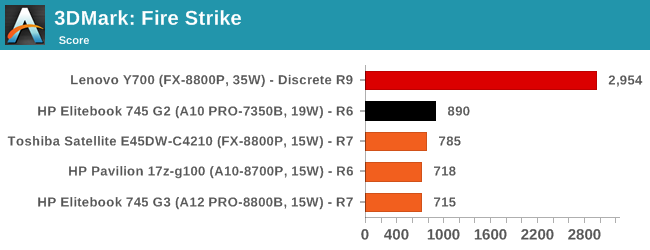
The last two benchmarks fall square with the dual channel configuration. The GDDR5 of the discrete graphics card in the Y700 wins out on all of them.
Rocket League
Hilariously simple pick-up-and-play games are great fun. I'm a massive fan of the Katamari franchise for that reason — passing start on a controller and rolling around, picking up things to get bigger, is extremely simple. Until we get a PC version of Katamari that I can benchmark, we'll focus on Rocket League. Rocket League combines the elements of pick-up-and-play, allowing users to jump into a game with other people (or bots) to play football with cars with zero rules. The title is built on Unreal Engine 3 and it allows users to run the game on super-low-end systems while still taxing the big ones. Since the release earlier in 2015, it has sold over 5 million copies and seems to be a fixture at LANs and game shows.
With Rocket League, there is no benchmark mode, so we have to perform a series of automated actions. We take the following approach: Using Fraps to record the time taken to show each frame (and the overall frame rates), we use an automation tool to set up a consistent 4v4 bot match on easy, with the system applying a series of inputs throughout the run, such as switching camera angles and driving around. It turns out that this method is nicely indicative of a real bot match, driving up walls, boosting and even putting in the odd assist, save and/or goal, as weird as that sounds for an automated set of commands. To maintain consistency, the commands we apply are not random but time-fixed, and we also keep the map the same (Denham Park) and the car customization constant. We start recording just after a match starts, and record for 4 minutes of game time, with average frame rates, 99th percentile and frame times all provided. For these tests, we used the 1280x720 resolution at high settings. A bigger explanation of testing can be seen in our AMD A8-7670K APU review.

Built on UE3 and DX9, the game relies heavily on single threaded performance and at this level of detail, memory bandwidth. The Kaveri takes the crown, showing that at this level adding another stick of memory (and making sure you have the right configuration) is more important than a more advanced (or perhaps expensive) APU.
We’ll go into temperatures on the next page.















175 Comments
View All Comments
ncsaephanh - Monday, February 8, 2016 - link
Can you guys do a podcast on this article? Would love to hear you guys discuss it and also answer questions/comments on the article.ET - Monday, February 8, 2016 - link
Nice to see a Carrizo article finally, although it's rather disappointing, for example because only single channel was tested.You talked about solutions, here's how I see what AMD and publications like Anandtech need to do (I'm using Carrizo as an example, but it's a lesson for the future):
AMD: When Carrizo is available in a laptop, send one to Anandtech. Immediately. If you have a prototype before that, send that. We want to learn about the chip as quickly as possible, not have to wait months looking for nuggets of information on the web.
Anandtech: Benchmark the hell out of the laptop. If there's single channel with a dual channel option, show a comparative benchmark, but concentrate on dual. We're enthusiasts, we'll install a second DIMM to get better performance. For benchmarks, basic system performance and a plethora of games, and comparison to Intel, plus battery life. Deep dives are nice, but I'd rather have a quick overview of what the system is suitable for, and what kind of gaming it can achieve.
AMD: Desktop first! I know that laptops are where the money is, but desktop is where the enthusiasts are, and if your chip is worth anything, fans and publications like Anandtech will pair it with the fastest memory, configure it with the best TDP, and see what it's really capable of. OEM limitations will not get in the way.
AMD: Fans first! That's pretty much a repeat of the previous point, but AMD, you still have fans, and they are your best customers, not the OEM's or the clueless general public. If you make something that you think is good and you let your fans learn of it and get hold of it, they will tell you what they think and they will tell others. If you leave them in the dark, they will end up losing their enthusiasm.
Anandtech: Follow up on AMD stuff. It may be hard to get the latest AMD chips if AMD isn't helping, but at least let us know you're on it. An occasional news item telling us that you've tried to get some laptops for testing or whatnot will tell us that you're on it, and hopefully shame AMD and the OEM's enough to get a move on.
Personally, I would likely have bought a Carrizo system if there was one of similar size to my old Thinkpad X120e (which I still use, even if I'm not that happy with its speed). I might have bought a Carrizo for my HTPC if I could and I knew it provided decent enough performance.
sofocle10000 - Monday, February 8, 2016 - link
I just signed in to state that Asus had nice business/multimedia notebooks (I used N60DP/N56DP and I actually use an N551ZU - all based on AMD), and although my actual N551ZU is only based on the top of the line Kaveri, it is an exceptional machine for normal use/light gaming...Customers play a big part in the AMD problem, but if there were more incentives (take my current N551ZU, which is a great notebook for ~750-850 $, and if configured with an SSD, you could hardly tell it apart most of the time from the Intel i5H/i7QH + GTX 950M variants), not only a great price, but a better build quality, display, sound system the the market average, some of them would actually pay more attention to the AMD.
The OEM's should have a more defined bottom line for the AMD notebooks - were dual channel memory and a better display, a hybrid SSHD or a SSD are a must, especially for the models in the upper part of the price range 400-700 $...
dragosmp - Monday, February 8, 2016 - link
@Ian - great article, really a good example of investigative journalism. I'm happy this kind of articles are being revived, but being a reader of Tom's I see where this may be coming from.As the "guy that says what laptop/phone to buy" to my family and friends I have to say your findings and conclusions speak to me very clearly - AMD has a system-problem, not so much a CPU-problem (though some may argue differently). AMD chips are fed into cheap looking/feeling PCs with far too many corners cut, but this is how under 700$ market looks like. Could AMD's OEMs sell a 600$ 13" PC to compete with the CoreM UX305? I think not, simply because AMD's CPUs (who consume more) need thicker chassis with stronger cooling and a beefier battery and that costs money - so there's less available for the UX; even if the OEM accepted lower margins on the AMD PC, or AMD to sell the CPU at bargain prices, that design compared to the UX305 would be thicker and likely noisier.
If Zen is good, I could see it in a Mac as Apple has a history of doing good software. Or AMD should build their own surface line and set an example of what can be done.
Gunbuster - Monday, February 8, 2016 - link
People buy the cheapest $300 laptop they can get or something premium. Who are they targeting with these mid-rangers?farmergann - Tuesday, February 9, 2016 - link
Wife uses her Y700 for school and a few hours of photo editing every week. Exactly what she wanted. This article did a worthless job of representing the actual Y700 w/fx8800p you can pick up at Best Buy for $665-830. Everything is fantastic about it save for the TB HDD which I immediately replaced with a Samsung 850 Pro I had laying around.Somehow, this "investigative" nonsense missed the fact the U.S. Y700 has a superb little IPS screen with Freesync to go along with a surprisingly (truly) good sound system and -despite the author's claim- dual channel ram. Just for grins I've played BF3 and a few other games - none of which had issues. Great low/mid-range laptop with plenty of chops.
every1hasaids - Tuesday, February 9, 2016 - link
Nope, the US model is absolute garbage. They skimped on the VRMs and the laptop subsequently throttles in moderately intensive CPU tasks. Example, try running Cities: Skylines with a decent sized city and tell me that it doesn't stutter after about 20 seconds of play and every 5 seconds or so after that. The stutters which coincide with the CPU being utilized near 100% and the frequency dropping per resource monitor and Afterburner all the way down to 1.6ghz... Also I don't know what you're talking about with the Freesync capability, I could not get it to work after reading elsewhere that it may be possible.The main issue with a product like the Y700 is that the intel variant is only a couple hundred bucks more and you get a genuine quad core with HT, dual channel DDR4-2133 and comparable discreet graphics. Oh, and it has no trouble with voltage supply. Not to mention that the m.2 interface is PCI-E as opposed to SATA on the AMD model. It just doesn't make sense to purchase a far inferior product for only $200 less at the price point these models occupy.
farmergann - Thursday, February 11, 2016 - link
Cities: Skylines? LOL, that's about as rich as whining about Starcraft 2 performance on an FX Octacore - what were you expecting exactly? For people not looking to shove a laughably CPU bound title down a 35W laptop's throat, the FX8800p with user installed SSD is a far better choice, sorry guy.Peichen - Monday, February 8, 2016 - link
Wow, that's wasting a lot of time and words reviewing a product no one will buy. AMD needs to exist to keep the cheap Intel stuff dirt cheap but I don't feel anyone should waste time reviewing AMD CPU products. 10 years of marketing hype and under-delivery means AMD is actually slower than ever compares with Intel.I bought 2 AMD CPU over the last 6/7 years and frankly I wish I spend more buying Intel because I wouldn't have to spend time and money as often upgrading the CPU.
Danvelopment - Monday, February 8, 2016 - link
The way I see it, AMD needs to stop comparing themselves with themselves and needs to compare themselves with the competition. People don't understand the improvements if they aren't involved with the predecessor.They produce a reasonable product that performs at 60-80% of the competition at 50% of the price.
Good designs are produced for the competition, that could fundamentally have their parts, and they're losing on the design front.
And strangely, for similar products the AMD machines are the same cost, even though the difference is the chip (at halfish the price).
Can they not work to develop an easier transition method for OEM's to produce this-or-that designs that allow end users to pick AMD or Intel during the selection process. Tier them like Dell does for the various Intel processors but have them consistently show up as the cheapest option $100 off a $500 laptop is a decent drop and if the chip and PCB is $150 cheaper to produce the OEM still wins).
Differentiating the product creates too many variables people don't understand, and creates the issue above, CPU brand aversion on entire product stacks with no common ground.
I'd say take a long, hard look at current machines, and develop a method of getting their chips into them as an option, without OEMs designing a product from the ground up.
I'd certainly consider AMD if I could just select it as an option that knocks $100 off on the low cost tier laptop in my workplace.